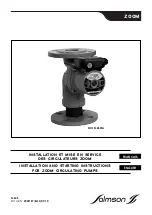
7. Discharge Arrangement
The user must install a Tundish in a position so that it is clearly visible and positioned away from electrical
devices. In addition, the discharge pipe from the Tundish should terminate in a safe place where there is no
risk to persons in the vicinity of the discharge, be of metal and:
(a) Must be at least one pipe size larger than the normal outlet size of the safety device unless its total
equipment hydraulic resistance exceeds that of a straight pipe 9m long, i.e. discharge pipes between 9m and
18m. Equivalent resistance length should be at least two sizes larger than the normal outlet size of the safety
device, between 18m and 27m at least three sizes larger and so on. Bends must be taken into account in
calculating the flow resistance. Refer to the diagram, tables and worked example detailed in Fig 7.
(b) Have a vertical section of pipe at least 600 mm long below the Tundish before any elbows or bends in the
pipe work.
(c) Be installed with a continuous fall.
(d) Have discharges visible at both Tundish and the final point of discharge, but where this is not possible or
practically difficult, examples of acceptable discharge arrangements are;
•
Ideally below a fixed grating and above the water seal in a trapped gully.
•
Downward discharge at low level, i.e. up to 100 mm above external surfaces such as car parks, hard standings,
grassed areas, etc. are acceptable providing that where children play or otherwise come into contact with
discharges, a wire cage or similar guard is positioned to prevent contact whilst maintaining visibility.
•
Discharge at high level, e.g. into a metal hopper and metal down pipe with the end of the discharge pipe
clearly visible (Tundish visible or not) or onto a roof capable of withstanding high temperature discharges of
water and 3m from any plastic guttering system that would collect such discharges (Tundish visible).
•
Where a single pipe serves a number of discharges such as in blocks of flats, the number served should be
limited to not more than six systems so that any installation discharging can be traced reasonably easily. The
single common discharge pipe should be at least one pipe size larger than the largest individual discharge
pipe to be connected. If unvented hot water stored systems are installed where discharges from safety devices
may not be apparent i.e. in dwellings occupied by blind, or disabled people, consideration should be given to
the installation of an electrically operated device to warn when discharge takes place.
WARNING: THE DISCHARGE WILL CONSIST OF SCALDING WATER AND STEAM. ASPHALT, ROOFING FELT AND
NON-METALLIC RAINWATER GOODS MAY BE DAMAGED BY SUCH DISCHARGES.
Fig 7. Table, worked example and diagram for discharge arrangement.
15
Valve outlet
size, di-
ameter in
‘inches’
Min size of dis-
charge pipe D1 in
‘mm’
Min size of dis-
charge pipe D2
from tundish in
‘mm’
Max resistance allowed,
expressed as a length
of straight pipe, i.e. no
elbows or bends
Resistance creat-
ed by each elbow
or bend in ‘m’
1/2
15
22
28
35
Up to 9
Up to 18
Up to 27
0.8
1.0
1.4
3/4
22
28
35
42
Up to 9
Up to 18
Up to 27
----
----
1.7
1
28
35
42
54
Up to 9
Up to 18
Up to 27
1.4
1.7
2.3
Sizing of copper discharge pipe “D2” for common temperature relief valve outlet sizes
Summary of Contents for 3C382B
Page 24: ...24 Notes ...
Page 38: ...14 Notes ...
















































